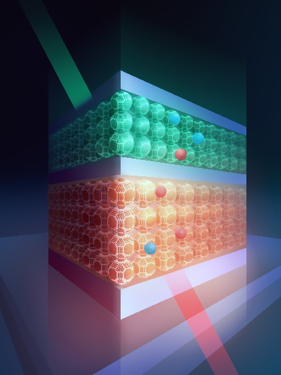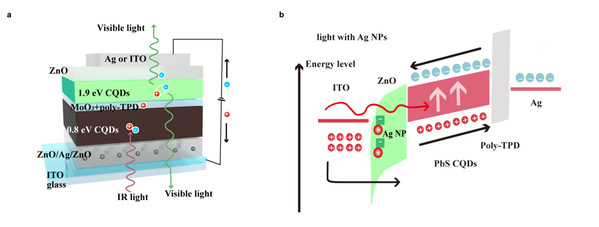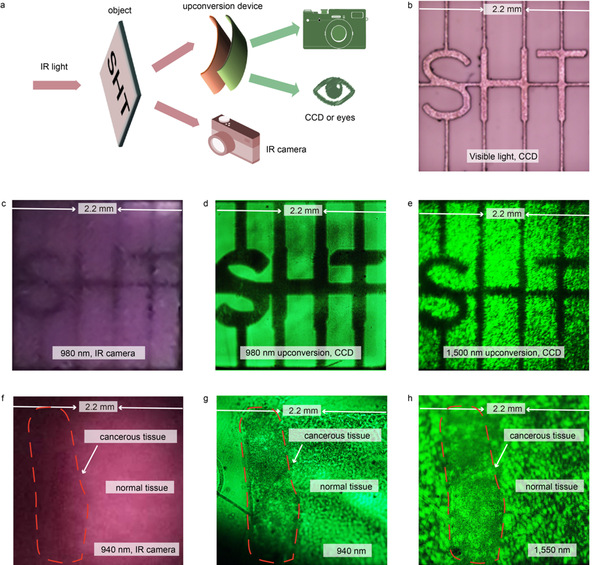Recently, Ning Zhijun's research group from School of Physical Science and Technology has reported a new type of infrared up-conversion photodetector based on colloidal quantum dots (CQDs) with low-cost and high-efficiency (Figure 1). The results was published in Nature Electronics with the title Solution-processed up-conversion photodetectors based on quantum dots.
Detection and imaging of near-infrared light plays an important role in the fields of biological detection, information communication, military, and meteorology. Traditional infrared imaging devices require the integration of infrared photodetectors and readout circuits. Complex integration processes have limited the development and application of infrared imaging system. As an alternative strategy, the infrared-visible up-conversion devices, which can convert infrared light into visible light that can be detected and imaging directly by commercial CCD, have the advantages of simple process and no need to integrate with the readout circuit. In other words, through the infrared up-conversion device, we can see infrared light directly.
Usually, the up-conversion process was realized through a linear conversion process of light-electricity-light by combined an infrared photodetector and a visible light LED, which is considered to be the most suitable detector structure in the field of infrared imaging. However, limited by the low photon-electron conversion efficiency of the infrared photodetector, the overall photon-photon conversion efficiency of the up-conversion device is low. In addition, most of the infrared up-conversion devices reported so far need to be prepared by a high-cost vacuum deposition method, and the working voltage of the reported infrared up-conversion devices is very high, which is not suitable for the preparation of flexible devices.
In order to the solve the issues above, Ning Zhijun's group prepared a new type of low-cost, high-efficiency infrared up-conversion photodetector based on CQDs. As shown in the detailed structure (Figure 2a), CQD materials are used as the infrared absorption layer and visible light emission layer. Benefiting from the properties of CQDs that can be processed by the solution method, the entire infrared up-conversion device is all prepared by the solution process except for the electrodes, which greatly simplifies the preparation of the device.
To improve the photon-to-photon conversion efficiency of infrared up-conversion devices, researchers introduced silver nanoparticles into the ZnO electron transport layer. In the absence of infrared light, there is a large energy barrier between the ITO electrode and zinc oxide. Holes cannot be injected into ZnO from ITO, and the current is small. When infrared light is incident, photo-generated electrons are trapped by Ag nanometers. The carriers are trapped and aggregated at the interface of ITO and ZnO. The electrons gathered at the interface increase the band bending of the device interface and reduce the barrier width. In this way, a large number of holes in ITO can injected into the ZnO by tunneling to achieve current multiplication (Figure 2b). Based on this mechanism, the external quantum efficiency of the CQD infrared detector can reach 8000%, while the detection rate can reach 6 × 1012 Jones and the response speed is in the order of milliseconds, which is comparable to the best performance of infrared photodetector based on CQDs reported so far.
The research team further combined this high-efficiency infrared photodetector with CQD light-emitting diodes to prepare an infrared up-conversion device and achieved a photon conversion efficiency of 6.5%. This is the highest of the two-terminal infrared up-conversion devices prepared by the solution method, and the turn-on voltage is only 2.5V. The researchers explored the application of the device in the field of bio-imaging. By irradiating mouse breast tissue with infrared light, normal tissue and cancerous tissue can be clearly distinguished with the help of the infrared up-conversion device (Figure 3), showing this infrared up-conversion devices have good application prospects in the field of biological imaging. In addition, this work also produced flexible infrared up-conversion devices for the first time, which is expected to be applied for wearable electronic devices.
The first author of the paper is Zhou Wenjia (Research Assistant Professor), and the corresponding author is Professor Ning Zhijun. Shanghai University is the first completion institution. The work was greatly assisted by Professor Edward H. Sargent and Dr. F. Pelayo García de Arquer from University of Toronto, as well as Huang Ruimin's research group from the Shanghai Institute of Materia Medica. Analytical Instrumentation Center of SPST and Chen Baile’s group of ShanghaiTech University provided support for the analysis and measurement. This work was also supported by the National Key Research and Development Program of China, the National Natural Science Foundation of China, and the Science and Technology Commission of Shanghai Municipality.

Figure 1 : Schematic of up-conversion device

Figure 2: (a) Structure of up-conversion device based on colloidal quantum dots (b) Energy Schematic of up-conversion device

Figure 3: Imaging results of the up-conversion devices based on quantum dots


